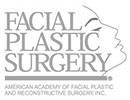Youthful eyelids appear full with a smooth transition from the inner corner to the outer corner of the eyelid. This youthful contour is the result of good skin and muscle tone with buoyant underlying fat pads. As we age or as a result of prior eyelid surgery all three components – skin, muscle and fat, change. Sunken eyes is a result of this process of aging.
Unfortunately, when too much of the central eyelid fat of the upper eyelid is removed during a cosmetic upper eyelid lift, a “hollowing” concavity may occur that gives the patient a tired and sunken eyes appearance. A change in the patient’s smooth eyelid contour occurs leading to an indented “A” frame deformity with a central peak.
Removing too much fat during an upper blepharoplasty may also make the patient look older than their stated age. These upper eyelid depressions can be avoided if the upper eyelid fat pads are conservatively contoured during surgery.
Hollowing of the superior eyelid sulcus following a blepharoplasty
Before and After Treatment of Sunken Eyes with hyaluronic acid filler (like Restylane or Juvederm) to correct the hollowing.
In contrast, occasionally, younger people can also appear to have sunken eyes but for different reasons. These upper eyelid “hollows” occur naturally and may due to an inherited tendency to develop fat atrophy or the size of their eye sockets are relatively large which allows their eyes to settle further backward giving them the appearance of deep -set dark sunken eyelids.
How Are Sunken Eyes Treated?
The objective of treatment is to restore the volume that has been lost either through progressive age related atrophy or as a result of previous surgery.
Different patient presentations and treatment options are available:
Restoration of upper eyelid volume to correct a sunken eye appearance revolves around either “free“ fat grafts obtained from a patient’s belly fat, a shift of the inner bulge of eyelid fat to an adjacent deficient area or injections of hyaluronic acid gels like Restylane, Juvederm XC, or Belotero beneath the skin in order to fill in the deficits.
Scenario 1
A patient who never underwent prior eyelid surgery but demonstrates a central upper eyelid concavity can have a correction of their deformity by surgically repositioning a pedicle of bulging inner eyelid fat in a lateral direction toward the central depression. A pedicle of bulging fat is shifted , still attached to a blood supply, from the inner corner of the eyelid to the more central depressed area and then sutured in place. This is a long term solution to correct a upper eyelid concavity.
Scenario 2
If a patient does not have enough fat to shift into the upper eyelid hollows then the surgeon may consider a free fat graft (not attached to a blood supply). Free fat, usually obtained from your abdomen or hip is a natural alternative to dermal fillers to correct superior sulcus depressions. These fat grafts are typically placed deep below the skin and they will typically last longer than a dermal fillers. However, extracting fat from another area of your body requires a minor micro-liposuction procedure usually from near your belly button or hip.This free fat is living tissue is composed of cells that do not always survive and fat obtained from other areas of your body can expand or contract with a gain or loss of your body weight.
Scenario 3
A third option occurs when a patient does not want any surgical intervention to correct the superior eyelid depressions. Then an injection of a H/A (hyaluronic acid) dermal fillers like Restylane, Juvederm XC, or Belotero is an option that will help to remedy the problem.The advantage of using a filler is that the procedure is quick, reversible, and will provide almost immediate results. The downsides of H/A fillers are they not a permanent solution and require repeat injections (approximately every year) to maintain the improvement. Often patients will opt to have a filler first before they move onto a more permanent solution like a fat graft.
How are Sunken Eyes fixed with fillers?
Around the eyelids, I prefer to inject dermal fillers with blunt needles called micro-cannulas. In my opinion, micro-cannulas provide a safer method compared to sharp needle punctures around the eye. Because these cannulas are blunt this method reduces the chance of bruising from the procedure. In addition, H/A fillers have the added benefit of being easily reversible so if you don’t like the appearance of a fuller eyelid contour for what ever reason, hyaluronic acid fillers they can be immediately reversed with an enzyme called hyaluronidase.
Look For A Specialist To Correct Your Sunken Eyes
If you are seeking solutions to correct upper eyelid hollow contour deformities you should seek out an eyelid specialist who has the experience to assess your problems and the skill to masterfully inject fat or dermal fillers to restore your natural beautiful eyelid contours.






